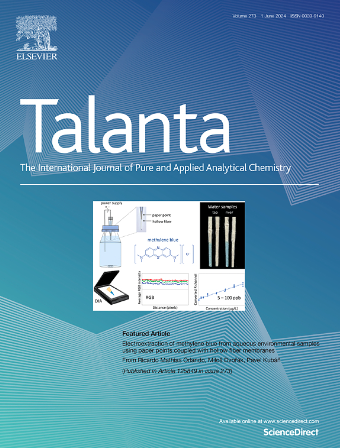Rapid detection of impurity particles in etching solutions using electrospray-differential mobility analysis
IF 5.6
1区 化学
Q1 CHEMISTRY, ANALYTICAL
引用次数: 0
Abstract
Particle defects, caused by impurity particles presenting in the chemical solution used in the semiconductor processing, directly impact yield and quality in the semiconductor industry. Early detection and removal of these particles at the chemical supply stage, for example, the etching solution, are crucial. This study presents a new methodology, based on electrospray-differential mobility analysis (ES-DMA), for detecting and quantifying specific organic impurity particles in etching solutions, a highly challenging task with existing methods to date. The results demonstrate that co-solvent with moderate volatility (e.g., H2O and dimethyl sulfoxide in this study) in the simulated etching solution can be effectively removed for subsequent analysis by generating fine, uniform droplets using electrospray ionization (ES). Using this approach, we successfully identified and quantified model organic impurity particles, including polyethylene glycol (PEG100K; hydrophilic and neutrally-charged) and bovine serum albumin (BSA; amphoteric). The technique achieved detection of ultrafine particles smaller than 10 nm, with a detection limit as low as 10 ppm, even in the presence of high-concentration nonvolatile solutes (e.g., 2 wt% citric acid, used as the representative etchant). These results demonstrate the capability of this ES-DMA method to isolate and analyze specific organic impurity types within complex chemical matrices. Overall, this approach shows strong potential for enhancing quality control in semiconductor manufacturing by enabling early-stage identification of trace-level organic contaminants, leading to better quality control in advanced manufacturing.

用电喷雾差分迁移率分析快速检测蚀刻溶液中的杂质颗粒
颗粒缺陷是由半导体加工中使用的化学溶液中存在的杂质颗粒引起的,它直接影响半导体工业的成品率和质量。在化学品供应阶段(例如蚀刻溶液)早期检测和去除这些颗粒至关重要。本研究提出了一种基于电喷涂差分迁移率分析(ES-DMA)的新方法,用于检测和定量蚀刻溶液中的特定有机杂质颗粒,这是迄今为止现有方法的一项极具挑战性的任务。结果表明,通过电喷雾电离(ES)产生细小、均匀的液滴,可以有效地去除模拟蚀刻溶液中具有中等挥发性的共溶剂(例如本研究中的H2O和二甲亚砜),用于后续分析。利用这种方法,我们成功地鉴定和量化了模型有机杂质颗粒,包括聚乙二醇(PEG100K;亲水性和中性电荷)和牛血清白蛋白(BSA;两性)。该技术实现了对小于10nm的超细颗粒的检测,检测限低至10ppm,即使存在高浓度非挥发性溶质(例如,2%的柠檬酸,用作代表性蚀刻剂)。这些结果证明了ES-DMA方法在复杂化学基质中分离和分析特定有机杂质类型的能力。总的来说,这种方法通过早期识别微量有机污染物,显示出加强半导体制造质量控制的强大潜力,从而在先进制造中实现更好的质量控制。
本文章由计算机程序翻译,如有差异,请以英文原文为准。
求助全文
约1分钟内获得全文
求助全文
来源期刊

Talanta
化学-分析化学
CiteScore
12.30
自引率
4.90%
发文量
861
审稿时长
29 days
期刊介绍:
Talanta provides a forum for the publication of original research papers, short communications, and critical reviews in all branches of pure and applied analytical chemistry. Papers are evaluated based on established guidelines, including the fundamental nature of the study, scientific novelty, substantial improvement or advantage over existing technology or methods, and demonstrated analytical applicability. Original research papers on fundamental studies, and on novel sensor and instrumentation developments, are encouraged. Novel or improved applications in areas such as clinical and biological chemistry, environmental analysis, geochemistry, materials science and engineering, and analytical platforms for omics development are welcome.
Analytical performance of methods should be determined, including interference and matrix effects, and methods should be validated by comparison with a standard method, or analysis of a certified reference material. Simple spiking recoveries may not be sufficient. The developed method should especially comprise information on selectivity, sensitivity, detection limits, accuracy, and reliability. However, applying official validation or robustness studies to a routine method or technique does not necessarily constitute novelty. Proper statistical treatment of the data should be provided. Relevant literature should be cited, including related publications by the authors, and authors should discuss how their proposed methodology compares with previously reported methods.
 求助内容:
求助内容: 应助结果提醒方式:
应助结果提醒方式:


